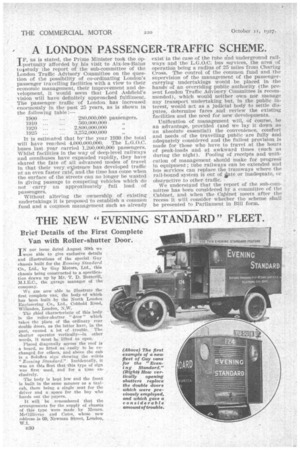A LONDON PASSENGER-TRAFFIC SCHEME.
Page 56

If you've noticed an error in this article please click here to report it so we can fix it.
IF, as is stated, the Prime Minister took the opportunity afforded by his visit to Aix-les-Bains to istudy the report of the sub-committee of the London Traffic Advisory Committee On the question of the possibility of co-ordinating London's passenger travelling facilities with a view to their economic management, their improvement and development, it would seem that Lord Ashfield's vision will have definitely approached fulfilment. The passenger traffic of London has increased enormously in the past 25 years, as is shown in the following table:— .. • It is estirnated that by the year 1930 the total will have reached 4,000,000,000. The L.G.O.C. buses last . year carried 1,200,000,000 passengers. Whilst facilities in the way of deep-level railways and omnibuses have expanded rapidly, they have shared the fate of all advanced modes of travel in that 'their very mitstence has developed traffic at an even faster rate, and. the time has come when the surface of the streets canno longer be wasted . In giving passage to competing vehicles which do not carry an approximately full load of .
Without altering the ownership of existing undertakings it is proposed to establish a common • fund and a common management Such as already exist in the case of the tube a.nd iindergronnd railways and the L.G.O.C. bus services, the area of operation being a radius of 25 miles from Charing Cross. The control of the common fund and the supervision of the management of the passengercarrying undertakings would be placed in the hands' of an overriding public .authority (the present London Traffic Advisory Committee is recommended), which would neither own nor manage any transport undertaking but, in the public interest, would act as a judicial body to settle disputes, determine fares and review the existing facilities and the need for new developments.
Unification of management will, of course, be an advantage, provided (and we lay it down as an absolute essential) the convenience, comfort and needs of the travelling public -are fully and adequately considered and the fullest provision is made for those who have to travel at the hours of peak-loads and at awkward times. (such as 'during the night): Pooling of receipts and unitieatiOn of management should make for progressi in equipment; tube railways can be extended and bus services can replace the tramways where the rail-bound system is out of gate or inadequate, or obstructive to other traffic.
We understand that the report of the sub-committee has been considered by a committee of the Cabinet, and when the Carbinet meets after the recess it will consider whether the scheme shall be presented to Parliament in Bill form.




















































































































